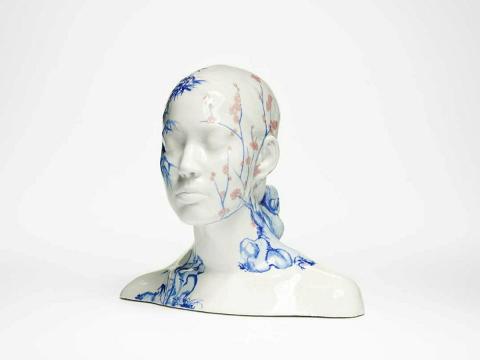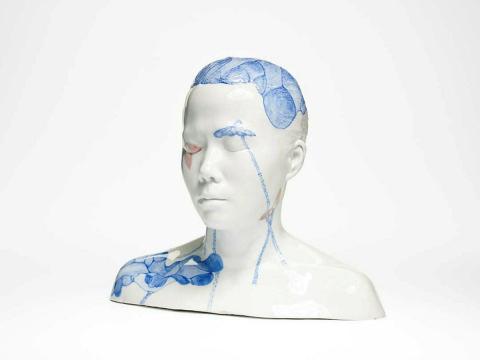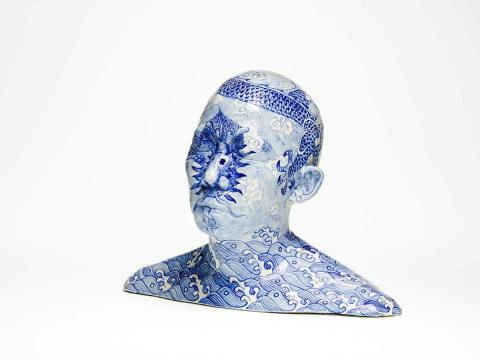AH XIAN: 'China China' series
Ah Xian was born in Beijing in 1960 and came to Australia in early 1989 as a visiting scholar to the University of Tasmania's School of Art, returning to China just weeks before the student demonstrations that led to violent confrontations at Tiananmen Square in June 1989. Deeply affected by these events, Ah Xian sought political asylum in Australia in 1990 along with his brother, Liu Xiao Xian, also an artist.
Working with porcelain, jade, lacquer and cloisonné, Ah Xian's contemporary innovations renew the meanings in Chinese cultural motifs and materials. His work was included in 'Face up: Contemporary Art from Australia' at the Hamburger Bahnhof, Museum of Contemporary Art, Berlin, Germany in early 2004 and in late 2003, Queensland Art Gallery hosted the exhibition 'Ah Xian', and in that same year Ah Xian held a solo exhibition, 'China Refigured: The Art of Ah Xian, with selections from the Rockefeller Collection', at the Asia Society and Museum, New York. In 2001, he won the 'National Sculpture Prize and Exhibition' at the National Gallery of Australia, for his Human human - lotus cloisonné figure 1 2000–01, which was subsequently acquired by the Queensland Art Gallery.
The group of four porcelain busts (2000.019–22) are among the first in a series by Ah Xian, called the 'China China' series. The 'China China' works are porcelain 'body copies' that have been cast from life models — men and women — and painted by the artist with traditional Chinese porcelain designs in underglaze blue (Qing Hua), underglaze red and some in overglaze enamels (Dou Cai). The brilliant white bodies, mostly heads and torsos, sometimes consciously distorted, display intimate individual details. Being porcelain, the once-precious material for which China is famous, they are at once permanent and fragile. China China - Bust no.1 uses a traditional Chinese scroll landscape. The sitter is Ah Xian's brother, Liu Xiao Xian.
Ah Xian decided to work in porcelain after considering cultural differences between the East and West. 'I believe that among the disadvantages in contemporary art is the sometimes violent and vulgar and temporary nature of the art produced so I try to minimise those things in my work and people recognise porcelain as being beautiful and perfect. I originally made similar forms using plastic which was also casual, although it is fragile like porcelain and looks like porcelain, the texture is not the same.'2
Ah Xian wanted to combine these ancient materials and techniques in a contemporary body of work, so he studied the basic skills of porcelain casting at the Sydney College of the Arts. In 1997 he travelled to Jingdezhen, famous for its kilns which for centuries have produced fine porcelain objects and vessels for the Chinese court, to learn the history and traditional way of making porcelain. His aim was to establish contacts and look into the possibility of spending a longer period of time to develop his technical knowledge of working in porcelain.3
In 1998 Ah Xian obtained an Australia Council grant which allowed him to spend nine months at the Jingdezhen kilns (in 1999) to work with master potters and painters. While in Jingdezhen, he learnt the processes of making the porcelain busts, which include moulding from life, forming (mould pressing), drying, glazing, decorating and firing. He went through all the procedures patiently, methodically, to ensure a successful outcome. During the process Ah Xian was mainly in charge of moulding, forming (collaborating with the forming master), and neatening to get a green piece completed. He was also taught how to glaze by using a spray can and how to blow the glaze by mouth.4 Curator Claire Roberts has said:
In creating the 'China China' series of porcelain figures Ah Xian continues his long philosophical journey. Living in Australia he has been released from the immediate pressures of Chinese politics. His distance from Chinese (physical) and Australian (cultural) society has created a space which has allowed these works to develop. He argues that he could not have produced such work in China. The 'China China' series is the considered result of a period of deeply-felt life experience in which he and his family have straddled two cultures — Chinese and Australian, eastern and western, 'old' and 'new'.5
Endnotes
- Ah Xian, 'Self-exile of the soul', paper delivered at a seminar on contemporary Asian art organised by the Asian Arts Society of Australia and held at the Art Gallery of New South Wales, Sydney; see TAASA Review, The Asian Art Society of Australia, vol. 8, no. 1, 1999, pp.8–9.
- Claire Roberts, Conversation with Ah Xian, January 1999.
- Claire Roberts, 'Ah Xian "China. China": Recent Works in Porcelain' in Beyond the Future: The Third Asia-Pacific Triennial of Contemporary Art [exhibition catalogue], Queensland Art Gallery, Brisbane, 1999, p.228.
- Louise Bender, Interview with Ah Xian, April 2000.
- Roberts, Beyond the Future: The Third Asia-Pacific Triennial of Contemporary Art [exhibition catalogue], p.228.
Connected objects

China China - Bust no.1 1998
- AH XIAN - Creator

China China - Bust no.3 1998
- AH XIAN - Creator

China China - Bust no.4 1998
- AH XIAN - Creator

China China - Bust no.10 1998
- AH XIAN - Creator